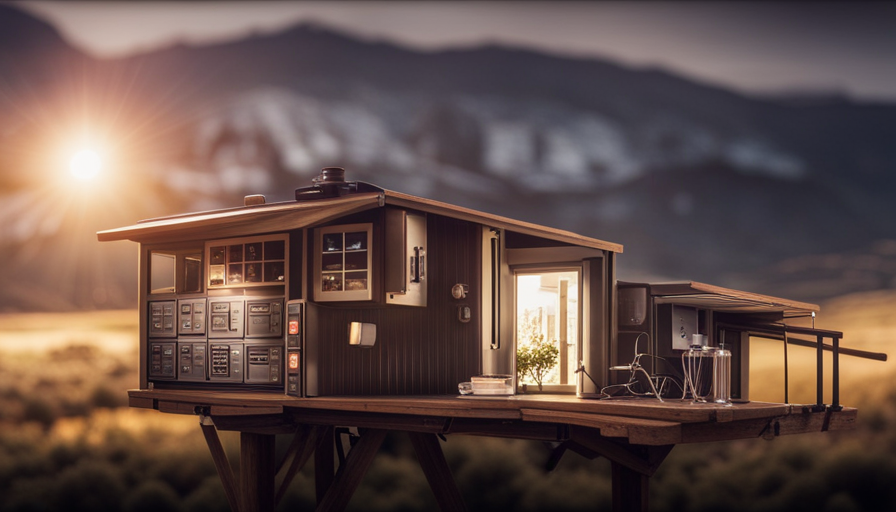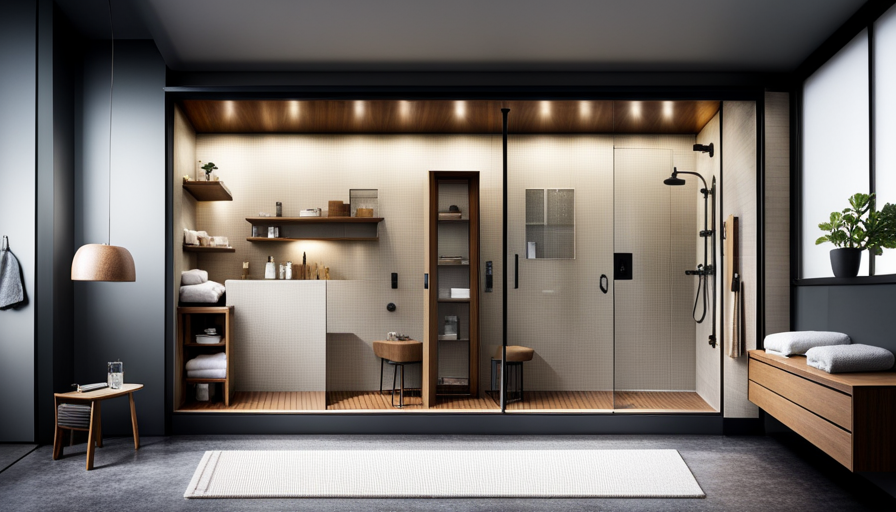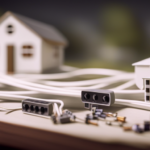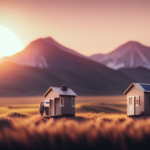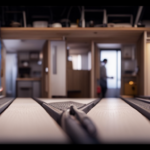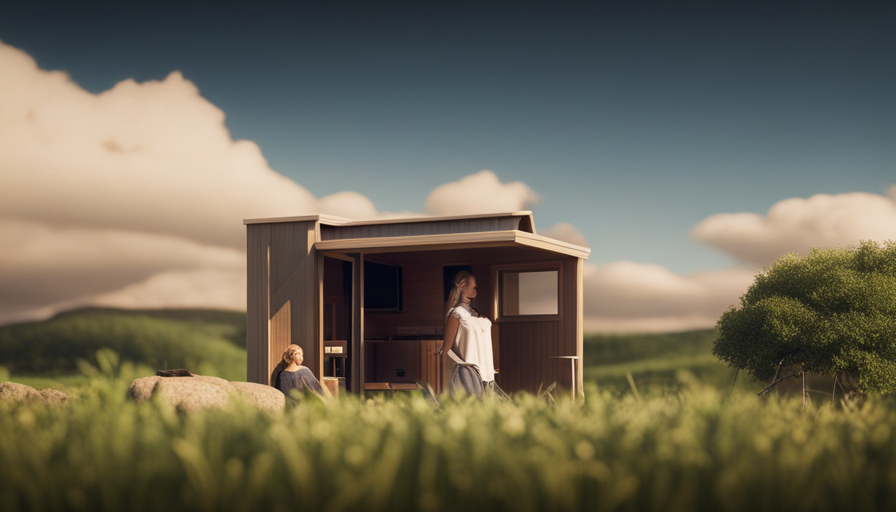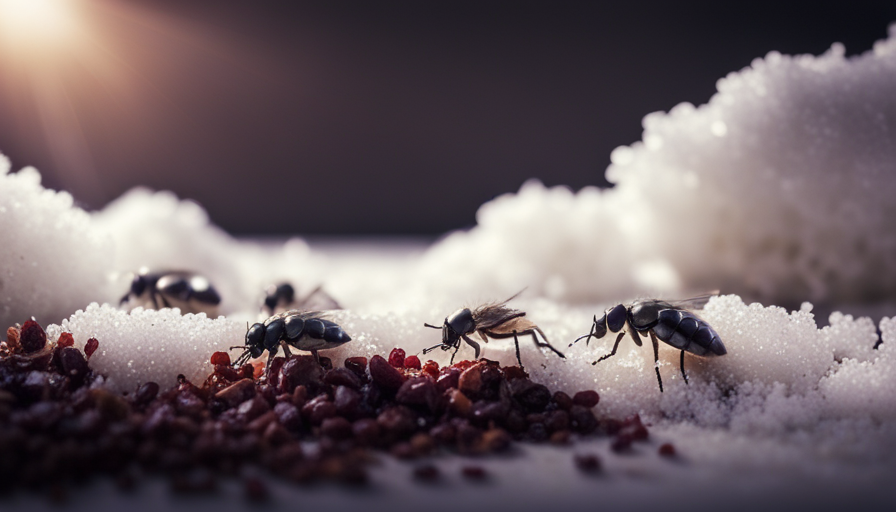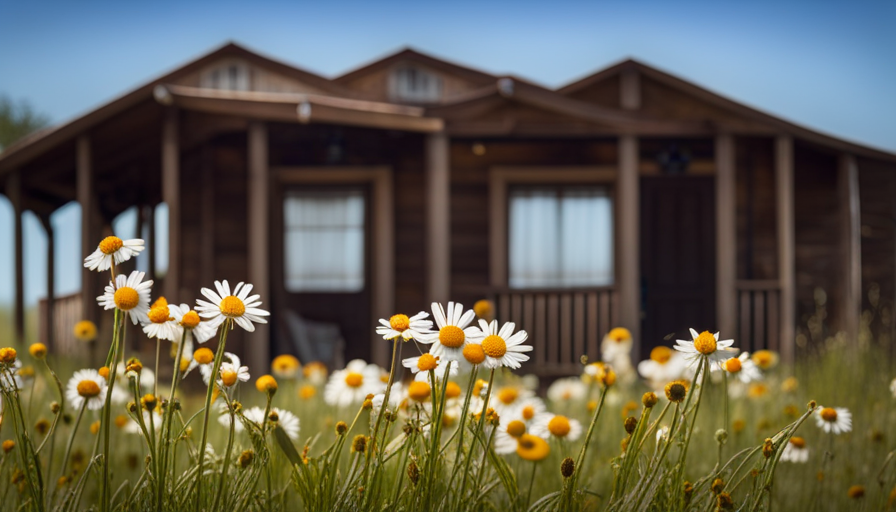When I first decided to live in a small house, the task of understanding how electricity works in a confined space was daunting. It seemed like a complex problem, but with proper knowledge and careful planning, I was able to create a reliable and efficient electrical system that meets all my needs.
Take for example, Sarah, a tiny house enthusiast who wanted to live off-grid in a remote location. She needed her tiny house to be self-sufficient, relying on renewable energy sources. By carefully selecting the right power source, designing an efficient electrical layout, and installing proper wiring and outlets, Sarah was able to power her tiny house without any compromises.
In this article, I will guide you through the process of understanding and implementing electricity in a tiny house. From choosing the right power source to troubleshooting common issues, I will provide you with the technical knowledge and detailed steps needed to create a functional electrical system that suits your unique needs.
So, let’s dive in and explore the fascinating world of electricity in a tiny house.
Key Takeaways
- Understanding electricity is crucial for efficient and reliable electrical systems in tiny houses.
- Renewable energy sources like solar panels or wind turbines are commonly used in tiny houses.
- Adhering to electrical codes is important for safety and minimizing hazards.
- Choosing the right power source depends on specific needs and location, with options including solar power, wind power, generator, or battery storage.
Understanding the Basics of Electrical Systems in Tiny Houses
Get ready to dive into the electrifying world of tiny houses and discover the awe-inspiring intricacies of their electrical systems. Understanding the basics of electrical systems in tiny houses is crucial for a safe and efficient living experience.
In these small dwellings, power generation plays a vital role. Most tiny houses rely on renewable energy sources such as solar panels or wind turbines to generate electricity. These power sources aren’t only environmentally friendly but also cost-effective in the long run.
When it comes to electrical systems in tiny houses, following the electrical code is essential. The electrical code sets the standards for wiring, grounding, and overall electrical safety. Adhering to these guidelines ensures that your tiny house meets the required safety standards and minimizes the risk of electrical hazards. It’s crucial to familiarize yourself with the electrical code to ensure that your electrical system is installed correctly and operates safely.
Now that you understand the basics of electrical systems in tiny houses, let’s move on to the next section about choosing the right power source for your tiny house. It’s important to select a power source that suits your specific needs and lifestyle.
Choosing the Right Power Source for Your Tiny House
Deciding on the appropriate power source for your compact dwelling is like selecting the perfect dance partner; it needs to be compatible with your needs and provide a seamless connection that keeps the rhythm flowing smoothly. When it comes to powering your tiny house, there are a few options to consider: solar power, wind power, generator, or battery storage. Each option has its own advantages and considerations.
Solar power is a popular choice for tiny houses due to its renewable nature and low maintenance requirements. With solar panels installed on the roof, you can harness the power of the sun to generate electricity. However, solar power may not be suitable for areas with limited sunlight or during cloudy days.
Wind power is another renewable energy option that can be used to generate electricity for your tiny house. By installing a wind turbine, you can harness the power of the wind to generate electricity. However, wind power may not be suitable for areas with low wind speeds.
If renewable energy is not a feasible option for your tiny house, you can consider using a generator or battery storage. A generator can provide a reliable source of power, but it requires fuel and regular maintenance. On the other hand, battery storage allows you to store excess energy generated by solar or wind power for later use.
Choosing the right power source for your tiny house depends on your specific needs and location. Consider factors such as availability of sunlight or wind, maintenance requirements, and the need for a reliable power source. By carefully weighing your options, you can ensure that your tiny house is powered efficiently and effectively. Moving forward, let’s discuss designing an efficient electrical layout for your tiny house.
Designing an Efficient Electrical Layout
Now, let’s delve into crafting a streamlined electrical layout for your compact dwelling.
When designing an efficient electrical layout for a tiny house, it’s crucial to maximize power usage while considering space constraints. One important aspect to consider is the placement of electrical panels and circuit breakers. These should be strategically positioned to allow for easy access and maintenance.
Additionally, organizing the wiring in a logical manner can help minimize the length of wire runs and reduce energy loss. This can be achieved by grouping together outlets and appliances that require similar power sources.
Furthermore, using energy-efficient appliances and LED lighting can significantly reduce power consumption. It’s also important to consider incorporating renewable energy sources such as solar panels or wind turbines to supplement the electrical needs of your tiny house. These alternative power sources can help minimize reliance on the grid and reduce utility costs.
By designing an efficient electrical layout, you can ensure that your tiny house is powered effectively and sustainably.
In the next section, we’ll explore the process of installing wiring and outlets in a tiny house, ensuring a seamless electrical system without disrupting the aesthetic appeal.
Installing Wiring and Outlets in a Tiny House
To ensure an efficient and visually appealing electrical system in your compact dwelling, consider strategically placing wiring and outlets. By grouping together appliances and outlets that require similar power sources, you can reduce wire runs and energy loss. This not only simplifies the installation process but also improves the overall functionality of your tiny house.
When it comes to wiring materials, it’s crucial to select those that meet electrical codes and standards. This ensures the safety and reliability of your electrical system. Copper wiring is the most commonly used material due to its excellent conductivity and durability. Additionally, consider using flexible conduit to protect the wires and allow for easier installation in tight spaces.
To further optimize your electrical layout, here are five key considerations:
- Determine the location of your main electrical panel and distribute power accordingly.
- Plan for sufficient outlets in every room to accommodate your power needs.
- Incorporate USB outlets for convenient charging of electronic devices.
- Install GFCI outlets in areas exposed to moisture, such as the kitchen and bathroom.
- Consider installing dimmer switches to control lighting intensity and save energy.
By carefully considering these factors and adhering to electrical codes, you can create a safe and efficient electrical system in your tiny house.
In the next section, we’ll discuss the importance of selecting energy-efficient appliances and devices.
Selecting Energy-Efficient Appliances and Devices
When choosing appliances and devices, it’s essential to prioritize energy efficiency to maximize the functionality and sustainability of your compact living space. By following a few energy-saving tips and selecting sustainable appliances, you can significantly reduce your electricity consumption in a tiny house.
One important consideration is to look for appliances that have received an Energy Star certification. These appliances meet strict energy efficiency guidelines set by the Environmental Protection Agency (EPA) and can help you save energy and money in the long run.
Additionally, opting for appliances with a high Energy Efficiency Ratio (EER) can further enhance energy savings.
Another energy-saving strategy is to choose appliances and devices that have a low standby power consumption. Standby power, also known as vampire power, refers to the electricity consumed by devices when they are not in use but still plugged in. By selecting devices with low standby power, you can minimize unnecessary energy waste.
Furthermore, consider investing in energy-efficient lighting options such as LED bulbs. LED bulbs use significantly less electricity than traditional incandescent bulbs and have a longer lifespan, making them a cost-effective choice.
Selecting energy-efficient appliances and devices is crucial for managing power consumption in a tiny house. By incorporating these sustainable choices, you can reduce your energy usage and create a more environmentally friendly living space.
Managing Power Consumption in a Tiny House
As you navigate the world of compact living, keeping a tight leash on your power-hungry devices is like herding cats in a bustling city. In a tiny house, where every watt counts, implementing power saving techniques and monitoring energy usage becomes essential.
Here are three sub-lists to help you manage power consumption effectively:
-
Energy-efficient lighting:
- Replace traditional incandescent bulbs with LED or CFL lights to save energy.
- Install motion sensors or timers to automatically turn off lights when not in use.
- Utilize natural light through well-placed windows and skylights to reduce reliance on artificial lighting.
-
Smart power management:
- Use power strips with individual switches to easily turn off multiple devices at once.
- Invest in smart power outlets that allow you to monitor and control energy usage remotely.
- Optimize power settings on electronic devices, such as enabling sleep mode or adjusting screen brightness.
-
Efficient heating and cooling:
- Insulate your tiny house properly to minimize heat transfer and reduce reliance on heating and cooling systems.
- Consider using energy-efficient appliances like heat pumps or radiant floor heating.
- Use window coverings, such as blinds or curtains, to regulate temperature and reduce energy loss.
Implementing these power saving techniques and monitoring energy usage can significantly reduce your electricity consumption in a tiny house. As we transition into exploring alternative energy options for off-grid living, it’s important to first optimize our power usage.
Exploring Alternative Energy Options for Off-Grid Living
One must consider alternative energy options for off-grid living in order to maximize efficiency and minimize reliance on traditional power sources. When it comes to powering a tiny house, solar panel installation and wind turbine efficiency are two popular options to explore.
Solar panels are a reliable and sustainable energy source for tiny houses. They convert sunlight into electricity through photovoltaic cells. By installing solar panels on the roof of a tiny house, one can harness the power of the sun and store excess energy in batteries for later use. This provides a constant and renewable source of electricity, even on cloudy days.
Another alternative energy option to consider is wind turbines. These devices use the power of the wind to generate electricity. By strategically placing wind turbines around a tiny house, one can take advantage of the natural wind patterns in the area. However, it is important to assess the wind conditions and ensure proper installation for optimal efficiency.
To compare these alternative energy options, the following table provides a breakdown of the key factors to consider:
| Energy Option | Solar Panels | Wind Turbines |
|---|---|---|
| Efficiency | High | Variable |
| Cost | Moderate | High |
| Reliability | High | Variable |
By examining these factors, one can make an informed decision about which alternative energy option is best suited for their tiny house.
Exploring alternative energy options such as solar panel installation and wind turbine efficiency is crucial for off-grid living in a tiny house. These options provide sustainable and reliable sources of electricity, reducing dependence on traditional power sources. However, before diving into electrical systems, it is important to consider safety considerations for a secure and efficient setup.
Safety Considerations for Electrical Systems in Tiny Houses
Ensuring the safety of your electrical systems is crucial for a worry-free and secure living experience in your tiny home. When it comes to electrical safety regulations in tiny houses, it is important to adhere to the same standards as traditional homes.
This includes using proper grounding techniques, installing circuit breakers, and following specific wire gauge requirements. Additionally, fire prevention measures should be implemented, such as installing smoke detectors and fire extinguishers, and keeping flammable materials away from electrical components.
It is also essential to regularly inspect your electrical system for any signs of wear or damage, and to promptly address any issues that arise. By staying vigilant and maintaining a well-functioning electrical system, you can prevent potential hazards and ensure the safety of your tiny home.
Transitioning into the subsequent section about troubleshooting common electrical issues in tiny houses, it is important to have a basic understanding of how to identify and resolve common problems that may arise.
Troubleshooting Common Electrical Issues in Tiny Houses
When it comes to electricity in a tiny house, safety is always a top priority. In my previous subtopic, I discussed the importance of considering safety when designing and installing electrical systems in tiny houses. Now, let’s delve into the next step of the process: troubleshooting common electrical issues that may arise.
Troubleshooting faulty wiring is a crucial skill for any tiny house owner. It involves identifying and rectifying problems such as loose connections, worn-out insulation, or overloaded circuits. One must have a keen eye for detail and a good understanding of electrical principles to effectively troubleshoot these issues.
In addition to faulty wiring, it is essential to be able to identify electrical hazards in a tiny house. These hazards can include exposed wires, outdated or damaged electrical equipment, or improper grounding. By promptly recognizing and addressing these hazards, you can mitigate the risk of electrical accidents and ensure the safety of your tiny house.
To evoke a sense of urgency and importance, here are three potential consequences of ignoring electrical issues:
- Fire hazard: Faulty wiring or electrical hazards can significantly increase the risk of a devastating fire in your tiny house.
- Electric shock: Exposed wires or improperly grounded systems can lead to severe electrical shocks, which can be life-threatening.
- Equipment damage: Ignoring electrical issues can result in damage to your appliances and other electrical equipment, leading to costly replacements and repairs.
Now that we understand the importance of troubleshooting and identifying electrical issues, let’s move on to the next section: tips for maintaining and upgrading your tiny house electrical system.
Tips for Maintaining and Upgrading Your Tiny House Electrical System
Maintaining and upgrading your electrical system in a tiny house is like tending to the beating heart of your cozy sanctuary. It’s crucial to ensure that your system is running smoothly and efficiently, especially when it comes to your solar panels and battery storage.
When it comes to maintaining solar panels, regular cleaning is essential. Dust, dirt, and debris can accumulate on the panels, reducing their efficiency. I recommend using a soft brush or cloth to gently remove any build-up. Additionally, inspect the panels for any signs of damage or wear, such as cracks or loose connections. If you notice any issues, it’s best to contact a professional for repairs.
Upgrading your battery storage is another important aspect of maintaining your electrical system. As your energy needs may grow over time, upgrading to a larger battery bank can provide you with more power and longer-lasting energy storage. It’s also worth considering investing in advanced battery technologies, such as lithium-ion batteries, which offer higher energy density and longer lifespan.
Maintaining and upgrading your tiny house electrical system requires attention to detail and a technical approach. By regularly maintaining your solar panels and considering upgrades to your battery storage, you can ensure that your electrical system continues to power your cozy sanctuary efficiently.
Frequently Asked Questions
How much does it cost to install electrical wiring and outlets in a tiny house?
The cost of installing electrical wiring and outlets in a tiny house depends on several factors. Cost considerations include the size of the house, the complexity of the electrical system, and the type of wiring materials used. Generally, the cost can range from $1,000 to $3,000.
It’s important to use high-quality wiring materials to ensure safety and efficient power distribution throughout the tiny house.
Can I connect my tiny house to the grid and use traditional electricity?
Yes, I can connect my tiny house to the grid and utilize traditional electricity. This option offers numerous advantages. By connecting to the grid, I can access a reliable and consistent power supply without the need for additional energy sources or storage systems.
This allows me to power all my appliances and devices seamlessly, just like in a conventional home. Moreover, it eliminates the hassle of managing and maintaining alternative energy systems.
What are the main safety considerations when it comes to electrical systems in tiny houses?
When it comes to electrical systems in tiny houses, there are important safety considerations to keep in mind. Adhering to electrical safety regulations is crucial to ensure the well-being of occupants.
This includes proper installation of wiring, grounding, and electrical outlets. Regular electrical system maintenance is also essential to prevent hazards such as short circuits or electrical fires.
Inspecting and testing the system periodically is necessary to identify and address any potential issues promptly.
Are there any specific regulations or codes that need to be followed when installing electrical systems in a tiny house?
Are there specific regulations and codes that need to be followed when installing electrical systems in a tiny house? Absolutely! When it comes to electrical safety guidelines for DIY installation in tiny houses, it’s crucial to adhere to the relevant regulations and codes.
These codes ensure that the electrical systems are installed correctly, minimizing the risk of electrical hazards. Familiarize yourself with local building codes, the National Electrical Code (NEC), and any additional regulations specific to tiny houses to ensure a safe and compliant electrical installation.
Can I use solar power as the main source of electricity for my tiny house, even if I live in an area with limited sunlight?
I can use solar power as the main source of electricity for my tiny house, even if I live in an area with limited sunlight. To address the issue of limited sunlight, I can explore backup power options such as battery storage systems or connecting to the utility grid as a backup.
Additionally, I can maximize solar power efficiency by incorporating innovative techniques like using solar trackers or installing highly efficient solar panels to make the most of the available sunlight.
Conclusion
As I reflect on the intricate workings of electricity in a tiny house, I am reminded of the delicate dance of a conductor leading an orchestra. Each wire and outlet, like the musicians, plays its part in creating a harmonious symphony of power.
The careful selection of power sources, efficient layout design, and mindful appliance choices are the notes that compose this beautiful melody. Just as a conductor must consider safety and troubleshoot issues, so too must we in maintaining and upgrading our tiny house electrical system.
Let us embrace the power of electricity and conduct our tiny house with precision and care.
Hi, I’m Emma. I’m the Editor in Chief of Tiny House 43, a blog all about tiny houses. While tree houses are often associated with childhood, they can be the perfect adult retreat. They offer a cozy space to relax and unwind, surrounded by nature. And since they’re typically built on stilts or raised platforms, they offer stunning views that traditional homes simply can’t match. If you’re looking for a unique and romantic getaway, a tree house tiny house might just be the perfect option.
